Marks & Spencer: Management Accounting Systems and Financial Analysis
VerifiedAdded on 2023/01/10
|21
|6465
|2
Report
AI Summary
This report delves into the realm of management accounting, exploring its significance in organizational decision-making, particularly within the context of Marks & Spencer. It examines various management accounting systems, including cost accounting, inventory management, job costing, and price optimization, highlighting their benefits and applications. The report further analyzes different reporting methods like job cost reports, profit and loss statements, inventory reports, and budget reports, critically evaluating their application. It also explores the advantages and disadvantages of planning tools used for budgetary control and compares how organizations adapt management accounting systems to address financial problems. The report provides a comprehensive overview of how management accounting aids in financial planning, performance management, and effective decision-making, ultimately contributing to organizational success.
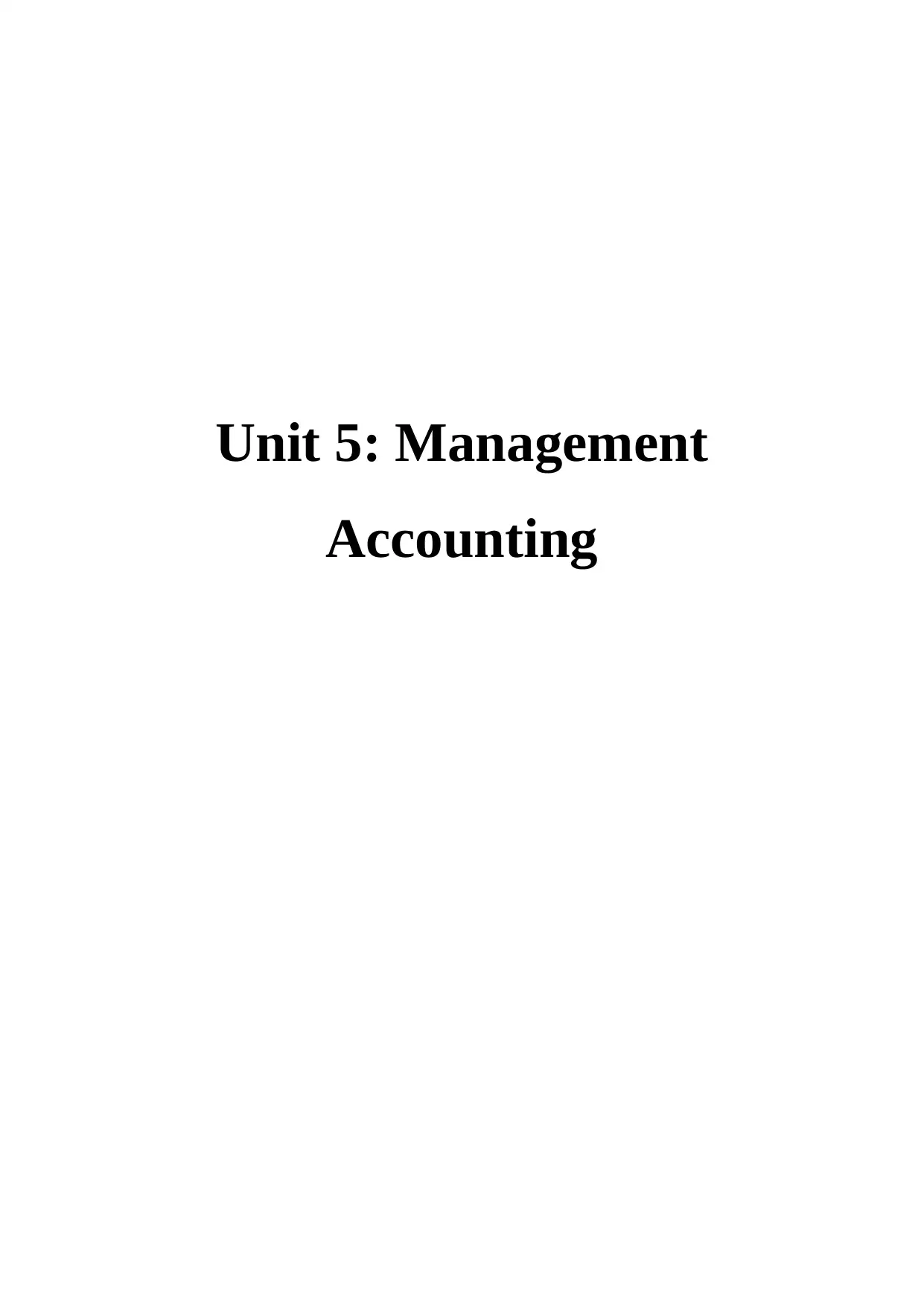
Unit 5: Management
Accounting
Accounting
Paraphrase This Document
Need a fresh take? Get an instant paraphrase of this document with our AI Paraphraser
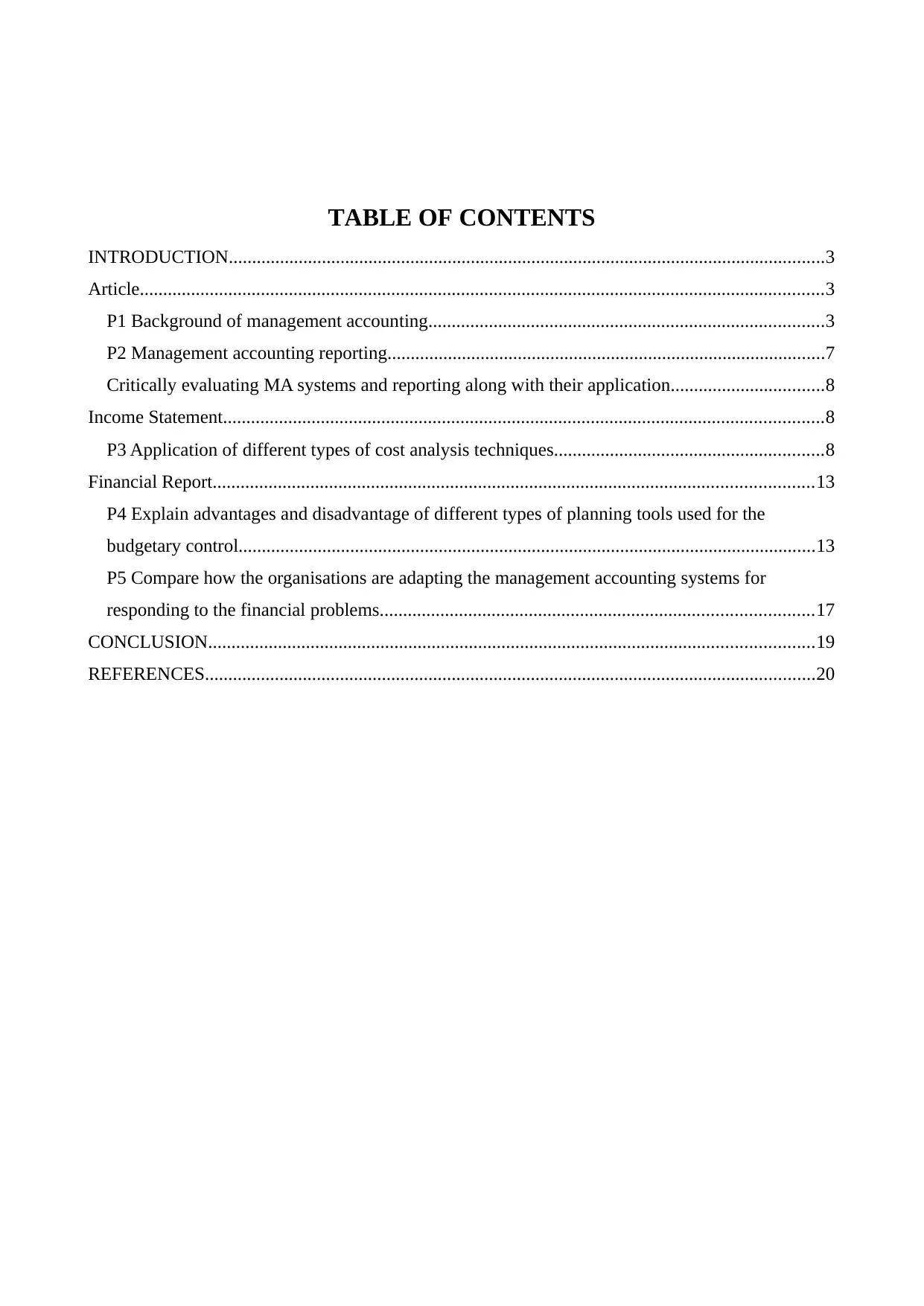
TABLE OF CONTENTS
INTRODUCTION................................................................................................................................3
Article...................................................................................................................................................3
P1 Background of management accounting.....................................................................................3
P2 Management accounting reporting..............................................................................................7
Critically evaluating MA systems and reporting along with their application.................................8
Income Statement.................................................................................................................................8
P3 Application of different types of cost analysis techniques..........................................................8
Financial Report.................................................................................................................................13
P4 Explain advantages and disadvantage of different types of planning tools used for the
budgetary control............................................................................................................................13
P5 Compare how the organisations are adapting the management accounting systems for
responding to the financial problems.............................................................................................17
CONCLUSION..................................................................................................................................19
REFERENCES...................................................................................................................................20
INTRODUCTION................................................................................................................................3
Article...................................................................................................................................................3
P1 Background of management accounting.....................................................................................3
P2 Management accounting reporting..............................................................................................7
Critically evaluating MA systems and reporting along with their application.................................8
Income Statement.................................................................................................................................8
P3 Application of different types of cost analysis techniques..........................................................8
Financial Report.................................................................................................................................13
P4 Explain advantages and disadvantage of different types of planning tools used for the
budgetary control............................................................................................................................13
P5 Compare how the organisations are adapting the management accounting systems for
responding to the financial problems.............................................................................................17
CONCLUSION..................................................................................................................................19
REFERENCES...................................................................................................................................20
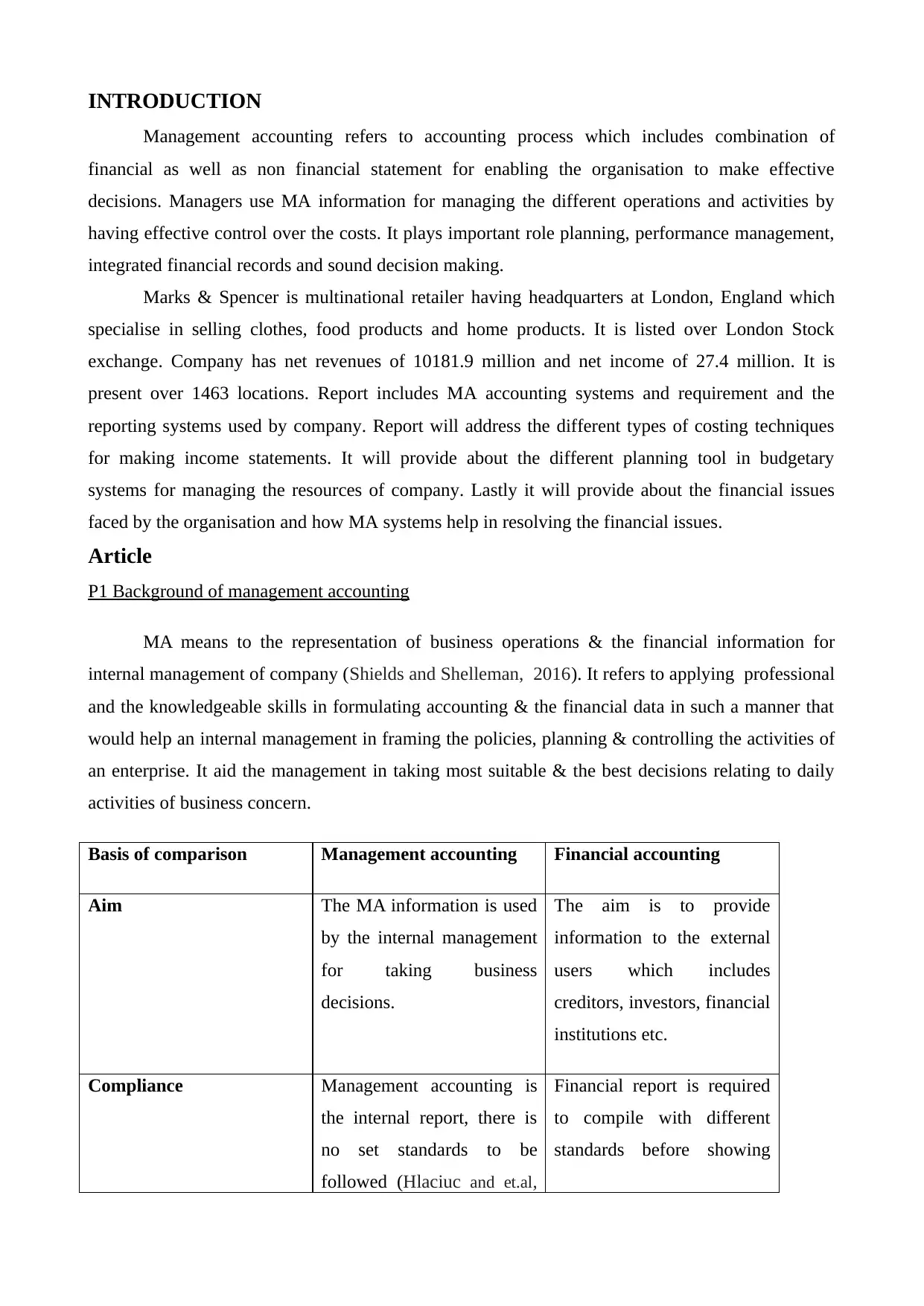
INTRODUCTION
Management accounting refers to accounting process which includes combination of
financial as well as non financial statement for enabling the organisation to make effective
decisions. Managers use MA information for managing the different operations and activities by
having effective control over the costs. It plays important role planning, performance management,
integrated financial records and sound decision making.
Marks & Spencer is multinational retailer having headquarters at London, England which
specialise in selling clothes, food products and home products. It is listed over London Stock
exchange. Company has net revenues of 10181.9 million and net income of 27.4 million. It is
present over 1463 locations. Report includes MA accounting systems and requirement and the
reporting systems used by company. Report will address the different types of costing techniques
for making income statements. It will provide about the different planning tool in budgetary
systems for managing the resources of company. Lastly it will provide about the financial issues
faced by the organisation and how MA systems help in resolving the financial issues.
Article
P1 Background of management accounting
MA means to the representation of business operations & the financial information for
internal management of company (Shields and Shelleman, 2016). It refers to applying professional
and the knowledgeable skills in formulating accounting & the financial data in such a manner that
would help an internal management in framing the policies, planning & controlling the activities of
an enterprise. It aid the management in taking most suitable & the best decisions relating to daily
activities of business concern.
Basis of comparison Management accounting Financial accounting
Aim The MA information is used
by the internal management
for taking business
decisions.
The aim is to provide
information to the external
users which includes
creditors, investors, financial
institutions etc.
Compliance Management accounting is
the internal report, there is
no set standards to be
followed (Hlaciuc and et.al,
Financial report is required
to compile with different
standards before showing
Management accounting refers to accounting process which includes combination of
financial as well as non financial statement for enabling the organisation to make effective
decisions. Managers use MA information for managing the different operations and activities by
having effective control over the costs. It plays important role planning, performance management,
integrated financial records and sound decision making.
Marks & Spencer is multinational retailer having headquarters at London, England which
specialise in selling clothes, food products and home products. It is listed over London Stock
exchange. Company has net revenues of 10181.9 million and net income of 27.4 million. It is
present over 1463 locations. Report includes MA accounting systems and requirement and the
reporting systems used by company. Report will address the different types of costing techniques
for making income statements. It will provide about the different planning tool in budgetary
systems for managing the resources of company. Lastly it will provide about the financial issues
faced by the organisation and how MA systems help in resolving the financial issues.
Article
P1 Background of management accounting
MA means to the representation of business operations & the financial information for
internal management of company (Shields and Shelleman, 2016). It refers to applying professional
and the knowledgeable skills in formulating accounting & the financial data in such a manner that
would help an internal management in framing the policies, planning & controlling the activities of
an enterprise. It aid the management in taking most suitable & the best decisions relating to daily
activities of business concern.
Basis of comparison Management accounting Financial accounting
Aim The MA information is used
by the internal management
for taking business
decisions.
The aim is to provide
information to the external
users which includes
creditors, investors, financial
institutions etc.
Compliance Management accounting is
the internal report, there is
no set standards to be
followed (Hlaciuc and et.al,
Financial report is required
to compile with different
standards before showing
⊘ This is a preview!⊘
Do you want full access?
Subscribe today to unlock all pages.

Trusted by 1+ million students worldwide
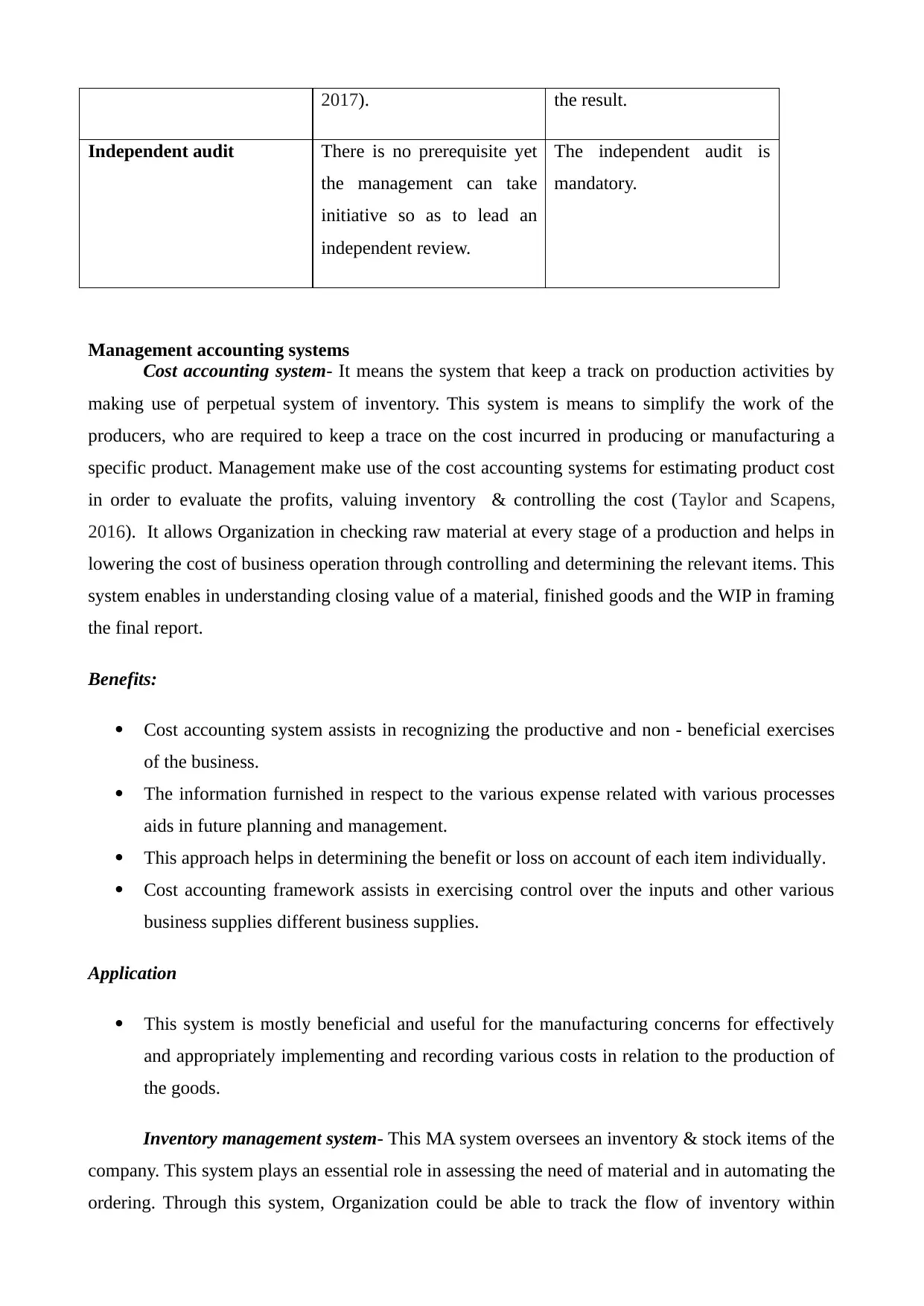
2017). the result.
Independent audit There is no prerequisite yet
the management can take
initiative so as to lead an
independent review.
The independent audit is
mandatory.
Management accounting systems
Cost accounting system- It means the system that keep a track on production activities by
making use of perpetual system of inventory. This system is means to simplify the work of the
producers, who are required to keep a trace on the cost incurred in producing or manufacturing a
specific product. Management make use of the cost accounting systems for estimating product cost
in order to evaluate the profits, valuing inventory & controlling the cost (Taylor and Scapens,
2016). It allows Organization in checking raw material at every stage of a production and helps in
lowering the cost of business operation through controlling and determining the relevant items. This
system enables in understanding closing value of a material, finished goods and the WIP in framing
the final report.
Benefits:
Cost accounting system assists in recognizing the productive and non - beneficial exercises
of the business.
The information furnished in respect to the various expense related with various processes
aids in future planning and management.
This approach helps in determining the benefit or loss on account of each item individually.
Cost accounting framework assists in exercising control over the inputs and other various
business supplies different business supplies.
Application
This system is mostly beneficial and useful for the manufacturing concerns for effectively
and appropriately implementing and recording various costs in relation to the production of
the goods.
Inventory management system- This MA system oversees an inventory & stock items of the
company. This system plays an essential role in assessing the need of material and in automating the
ordering. Through this system, Organization could be able to track the flow of inventory within
Independent audit There is no prerequisite yet
the management can take
initiative so as to lead an
independent review.
The independent audit is
mandatory.
Management accounting systems
Cost accounting system- It means the system that keep a track on production activities by
making use of perpetual system of inventory. This system is means to simplify the work of the
producers, who are required to keep a trace on the cost incurred in producing or manufacturing a
specific product. Management make use of the cost accounting systems for estimating product cost
in order to evaluate the profits, valuing inventory & controlling the cost (Taylor and Scapens,
2016). It allows Organization in checking raw material at every stage of a production and helps in
lowering the cost of business operation through controlling and determining the relevant items. This
system enables in understanding closing value of a material, finished goods and the WIP in framing
the final report.
Benefits:
Cost accounting system assists in recognizing the productive and non - beneficial exercises
of the business.
The information furnished in respect to the various expense related with various processes
aids in future planning and management.
This approach helps in determining the benefit or loss on account of each item individually.
Cost accounting framework assists in exercising control over the inputs and other various
business supplies different business supplies.
Application
This system is mostly beneficial and useful for the manufacturing concerns for effectively
and appropriately implementing and recording various costs in relation to the production of
the goods.
Inventory management system- This MA system oversees an inventory & stock items of the
company. This system plays an essential role in assessing the need of material and in automating the
ordering. Through this system, Organization could be able to track the flow of inventory within
Paraphrase This Document
Need a fresh take? Get an instant paraphrase of this document with our AI Paraphraser
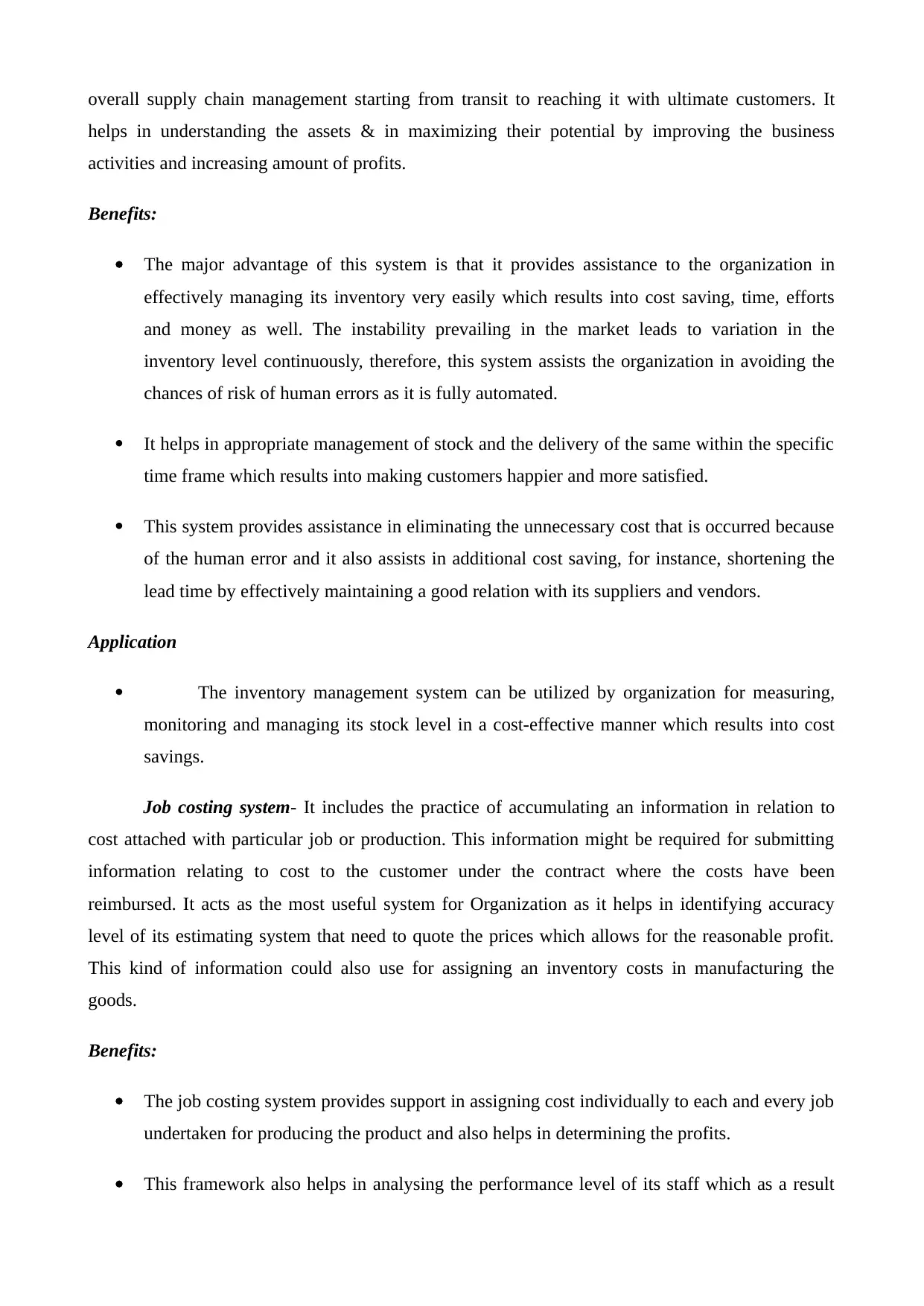
overall supply chain management starting from transit to reaching it with ultimate customers. It
helps in understanding the assets & in maximizing their potential by improving the business
activities and increasing amount of profits.
Benefits:
The major advantage of this system is that it provides assistance to the organization in
effectively managing its inventory very easily which results into cost saving, time, efforts
and money as well. The instability prevailing in the market leads to variation in the
inventory level continuously, therefore, this system assists the organization in avoiding the
chances of risk of human errors as it is fully automated.
It helps in appropriate management of stock and the delivery of the same within the specific
time frame which results into making customers happier and more satisfied.
This system provides assistance in eliminating the unnecessary cost that is occurred because
of the human error and it also assists in additional cost saving, for instance, shortening the
lead time by effectively maintaining a good relation with its suppliers and vendors.
Application
The inventory management system can be utilized by organization for measuring,
monitoring and managing its stock level in a cost-effective manner which results into cost
savings.
Job costing system- It includes the practice of accumulating an information in relation to
cost attached with particular job or production. This information might be required for submitting
information relating to cost to the customer under the contract where the costs have been
reimbursed. It acts as the most useful system for Organization as it helps in identifying accuracy
level of its estimating system that need to quote the prices which allows for the reasonable profit.
This kind of information could also use for assigning an inventory costs in manufacturing the
goods.
Benefits:
The job costing system provides support in assigning cost individually to each and every job
undertaken for producing the product and also helps in determining the profits.
This framework also helps in analysing the performance level of its staff which as a result
helps in understanding the assets & in maximizing their potential by improving the business
activities and increasing amount of profits.
Benefits:
The major advantage of this system is that it provides assistance to the organization in
effectively managing its inventory very easily which results into cost saving, time, efforts
and money as well. The instability prevailing in the market leads to variation in the
inventory level continuously, therefore, this system assists the organization in avoiding the
chances of risk of human errors as it is fully automated.
It helps in appropriate management of stock and the delivery of the same within the specific
time frame which results into making customers happier and more satisfied.
This system provides assistance in eliminating the unnecessary cost that is occurred because
of the human error and it also assists in additional cost saving, for instance, shortening the
lead time by effectively maintaining a good relation with its suppliers and vendors.
Application
The inventory management system can be utilized by organization for measuring,
monitoring and managing its stock level in a cost-effective manner which results into cost
savings.
Job costing system- It includes the practice of accumulating an information in relation to
cost attached with particular job or production. This information might be required for submitting
information relating to cost to the customer under the contract where the costs have been
reimbursed. It acts as the most useful system for Organization as it helps in identifying accuracy
level of its estimating system that need to quote the prices which allows for the reasonable profit.
This kind of information could also use for assigning an inventory costs in manufacturing the
goods.
Benefits:
The job costing system provides support in assigning cost individually to each and every job
undertaken for producing the product and also helps in determining the profits.
This framework also helps in analysing the performance level of its staff which as a result
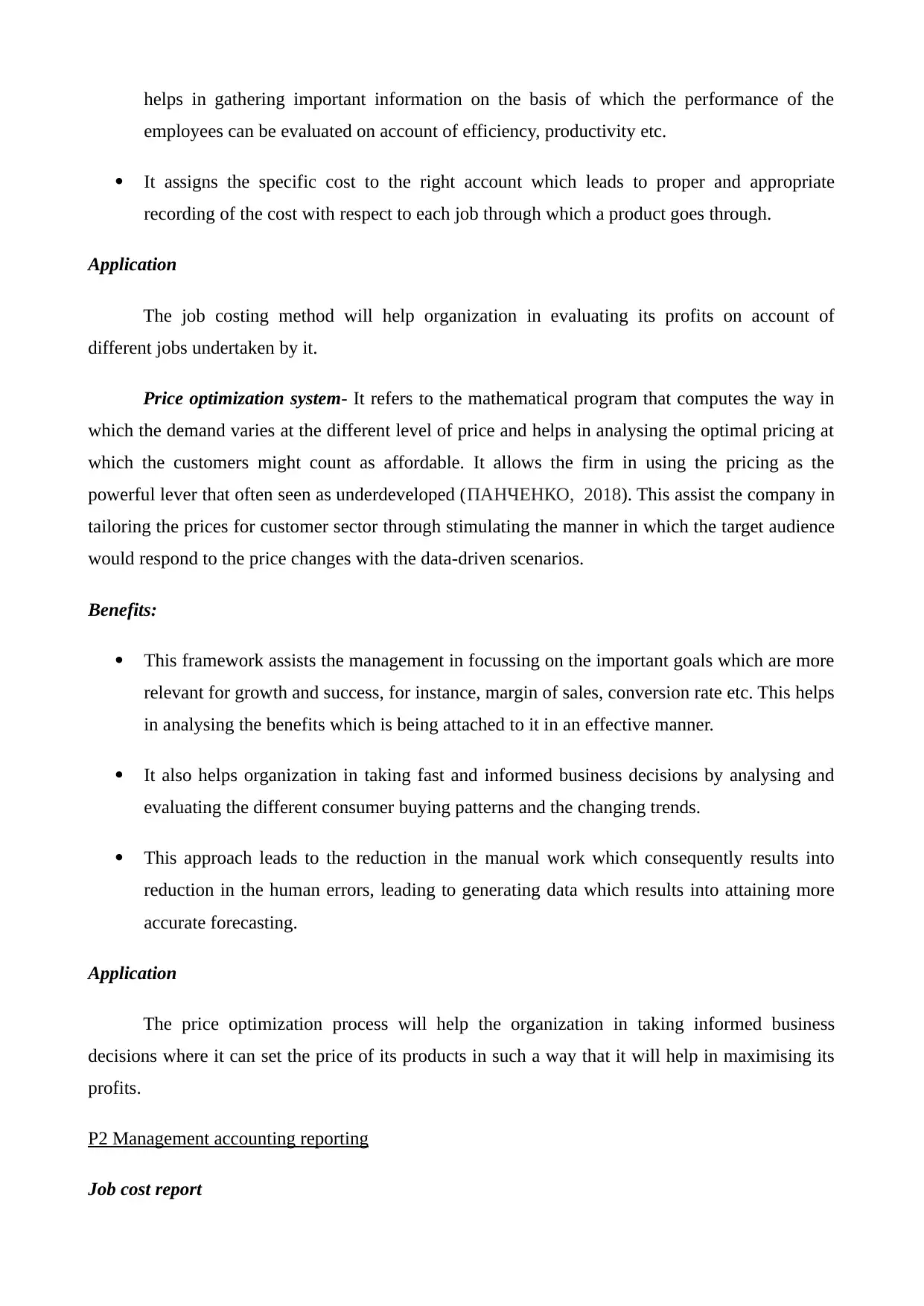
helps in gathering important information on the basis of which the performance of the
employees can be evaluated on account of efficiency, productivity etc.
It assigns the specific cost to the right account which leads to proper and appropriate
recording of the cost with respect to each job through which a product goes through.
Application
The job costing method will help organization in evaluating its profits on account of
different jobs undertaken by it.
Price optimization system- It refers to the mathematical program that computes the way in
which the demand varies at the different level of price and helps in analysing the optimal pricing at
which the customers might count as affordable. It allows the firm in using the pricing as the
powerful lever that often seen as underdeveloped (ПАНЧЕНКО, 2018). This assist the company in
tailoring the prices for customer sector through stimulating the manner in which the target audience
would respond to the price changes with the data-driven scenarios.
Benefits:
This framework assists the management in focussing on the important goals which are more
relevant for growth and success, for instance, margin of sales, conversion rate etc. This helps
in analysing the benefits which is being attached to it in an effective manner.
It also helps organization in taking fast and informed business decisions by analysing and
evaluating the different consumer buying patterns and the changing trends.
This approach leads to the reduction in the manual work which consequently results into
reduction in the human errors, leading to generating data which results into attaining more
accurate forecasting.
Application
The price optimization process will help the organization in taking informed business
decisions where it can set the price of its products in such a way that it will help in maximising its
profits.
P2 Management accounting reporting
Job cost report
employees can be evaluated on account of efficiency, productivity etc.
It assigns the specific cost to the right account which leads to proper and appropriate
recording of the cost with respect to each job through which a product goes through.
Application
The job costing method will help organization in evaluating its profits on account of
different jobs undertaken by it.
Price optimization system- It refers to the mathematical program that computes the way in
which the demand varies at the different level of price and helps in analysing the optimal pricing at
which the customers might count as affordable. It allows the firm in using the pricing as the
powerful lever that often seen as underdeveloped (ПАНЧЕНКО, 2018). This assist the company in
tailoring the prices for customer sector through stimulating the manner in which the target audience
would respond to the price changes with the data-driven scenarios.
Benefits:
This framework assists the management in focussing on the important goals which are more
relevant for growth and success, for instance, margin of sales, conversion rate etc. This helps
in analysing the benefits which is being attached to it in an effective manner.
It also helps organization in taking fast and informed business decisions by analysing and
evaluating the different consumer buying patterns and the changing trends.
This approach leads to the reduction in the manual work which consequently results into
reduction in the human errors, leading to generating data which results into attaining more
accurate forecasting.
Application
The price optimization process will help the organization in taking informed business
decisions where it can set the price of its products in such a way that it will help in maximising its
profits.
P2 Management accounting reporting
Job cost report
⊘ This is a preview!⊘
Do you want full access?
Subscribe today to unlock all pages.

Trusted by 1+ million students worldwide
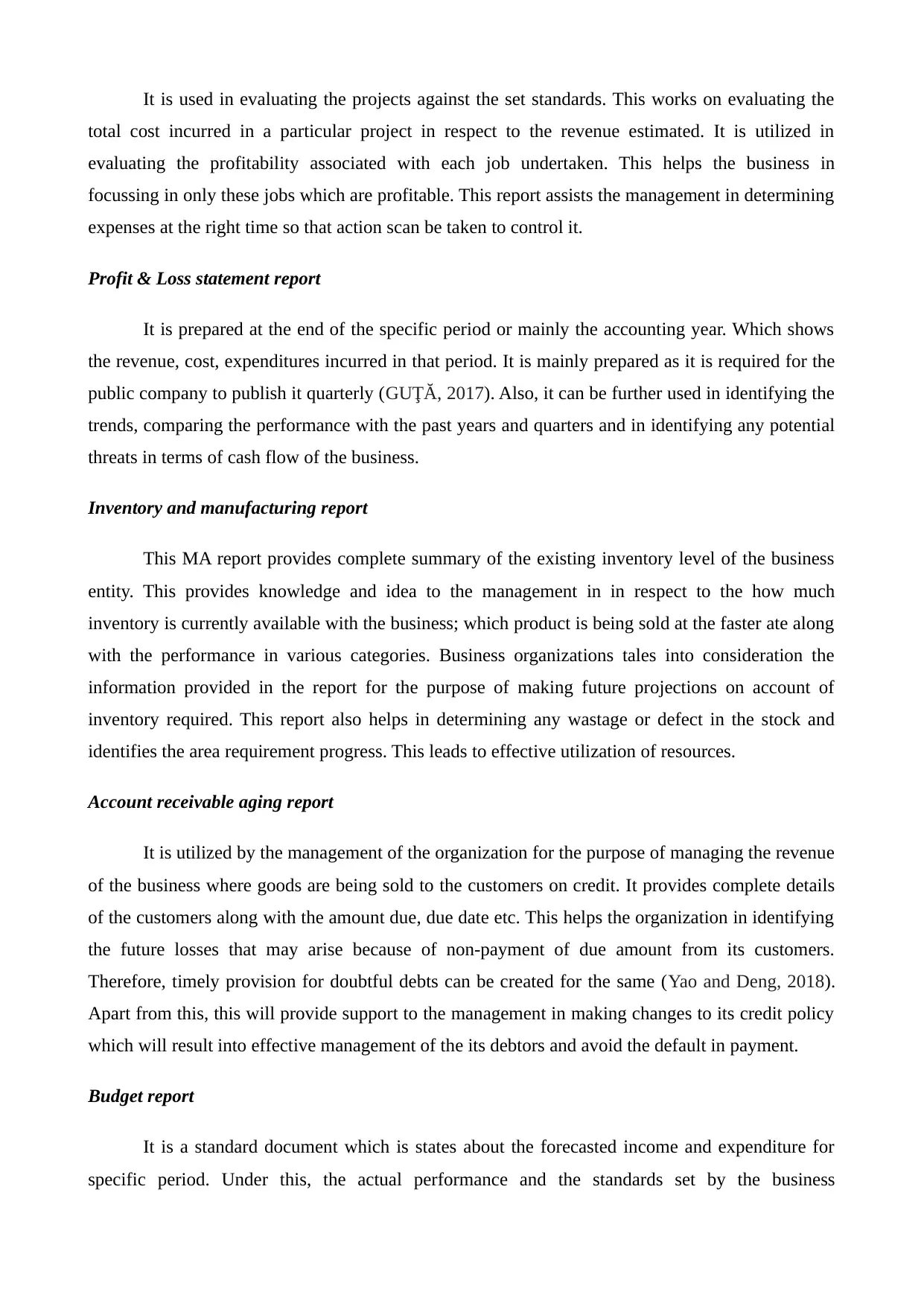
It is used in evaluating the projects against the set standards. This works on evaluating the
total cost incurred in a particular project in respect to the revenue estimated. It is utilized in
evaluating the profitability associated with each job undertaken. This helps the business in
focussing in only these jobs which are profitable. This report assists the management in determining
expenses at the right time so that action scan be taken to control it.
Profit & Loss statement report
It is prepared at the end of the specific period or mainly the accounting year. Which shows
the revenue, cost, expenditures incurred in that period. It is mainly prepared as it is required for the
public company to publish it quarterly (GUŢĂ, 2017). Also, it can be further used in identifying the
trends, comparing the performance with the past years and quarters and in identifying any potential
threats in terms of cash flow of the business.
Inventory and manufacturing report
This MA report provides complete summary of the existing inventory level of the business
entity. This provides knowledge and idea to the management in in respect to the how much
inventory is currently available with the business; which product is being sold at the faster ate along
with the performance in various categories. Business organizations tales into consideration the
information provided in the report for the purpose of making future projections on account of
inventory required. This report also helps in determining any wastage or defect in the stock and
identifies the area requirement progress. This leads to effective utilization of resources.
Account receivable aging report
It is utilized by the management of the organization for the purpose of managing the revenue
of the business where goods are being sold to the customers on credit. It provides complete details
of the customers along with the amount due, due date etc. This helps the organization in identifying
the future losses that may arise because of non-payment of due amount from its customers.
Therefore, timely provision for doubtful debts can be created for the same (Yao and Deng, 2018).
Apart from this, this will provide support to the management in making changes to its credit policy
which will result into effective management of the its debtors and avoid the default in payment.
Budget report
It is a standard document which is states about the forecasted income and expenditure for
specific period. Under this, the actual performance and the standards set by the business
total cost incurred in a particular project in respect to the revenue estimated. It is utilized in
evaluating the profitability associated with each job undertaken. This helps the business in
focussing in only these jobs which are profitable. This report assists the management in determining
expenses at the right time so that action scan be taken to control it.
Profit & Loss statement report
It is prepared at the end of the specific period or mainly the accounting year. Which shows
the revenue, cost, expenditures incurred in that period. It is mainly prepared as it is required for the
public company to publish it quarterly (GUŢĂ, 2017). Also, it can be further used in identifying the
trends, comparing the performance with the past years and quarters and in identifying any potential
threats in terms of cash flow of the business.
Inventory and manufacturing report
This MA report provides complete summary of the existing inventory level of the business
entity. This provides knowledge and idea to the management in in respect to the how much
inventory is currently available with the business; which product is being sold at the faster ate along
with the performance in various categories. Business organizations tales into consideration the
information provided in the report for the purpose of making future projections on account of
inventory required. This report also helps in determining any wastage or defect in the stock and
identifies the area requirement progress. This leads to effective utilization of resources.
Account receivable aging report
It is utilized by the management of the organization for the purpose of managing the revenue
of the business where goods are being sold to the customers on credit. It provides complete details
of the customers along with the amount due, due date etc. This helps the organization in identifying
the future losses that may arise because of non-payment of due amount from its customers.
Therefore, timely provision for doubtful debts can be created for the same (Yao and Deng, 2018).
Apart from this, this will provide support to the management in making changes to its credit policy
which will result into effective management of the its debtors and avoid the default in payment.
Budget report
It is a standard document which is states about the forecasted income and expenditure for
specific period. Under this, the actual performance and the standards set by the business
Paraphrase This Document
Need a fresh take? Get an instant paraphrase of this document with our AI Paraphraser
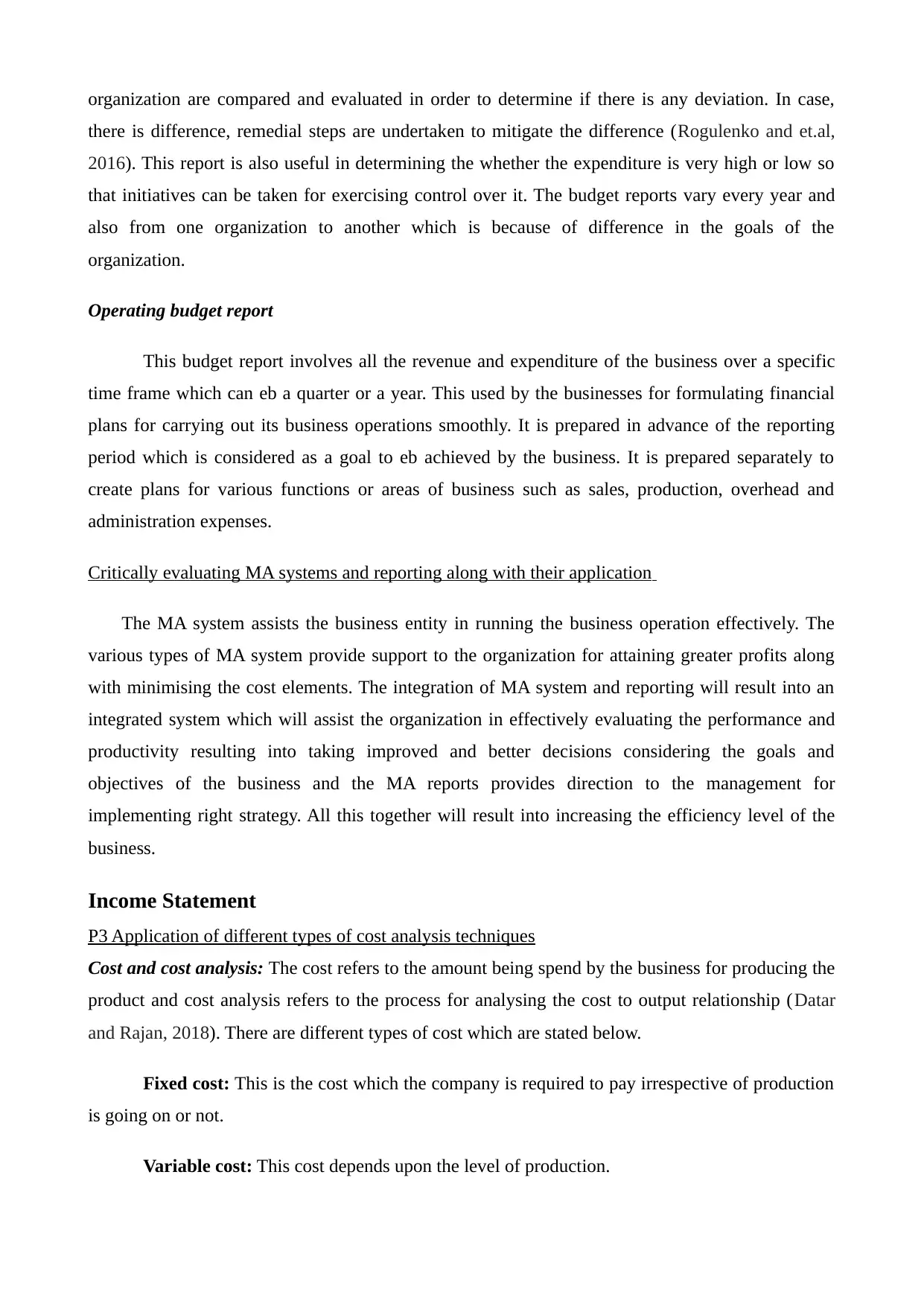
organization are compared and evaluated in order to determine if there is any deviation. In case,
there is difference, remedial steps are undertaken to mitigate the difference (Rogulenko and et.al,
2016). This report is also useful in determining the whether the expenditure is very high or low so
that initiatives can be taken for exercising control over it. The budget reports vary every year and
also from one organization to another which is because of difference in the goals of the
organization.
Operating budget report
This budget report involves all the revenue and expenditure of the business over a specific
time frame which can eb a quarter or a year. This used by the businesses for formulating financial
plans for carrying out its business operations smoothly. It is prepared in advance of the reporting
period which is considered as a goal to eb achieved by the business. It is prepared separately to
create plans for various functions or areas of business such as sales, production, overhead and
administration expenses.
Critically evaluating MA systems and reporting along with their application
The MA system assists the business entity in running the business operation effectively. The
various types of MA system provide support to the organization for attaining greater profits along
with minimising the cost elements. The integration of MA system and reporting will result into an
integrated system which will assist the organization in effectively evaluating the performance and
productivity resulting into taking improved and better decisions considering the goals and
objectives of the business and the MA reports provides direction to the management for
implementing right strategy. All this together will result into increasing the efficiency level of the
business.
Income Statement
P3 Application of different types of cost analysis techniques
Cost and cost analysis: The cost refers to the amount being spend by the business for producing the
product and cost analysis refers to the process for analysing the cost to output relationship (Datar
and Rajan, 2018). There are different types of cost which are stated below.
Fixed cost: This is the cost which the company is required to pay irrespective of production
is going on or not.
Variable cost: This cost depends upon the level of production.
there is difference, remedial steps are undertaken to mitigate the difference (Rogulenko and et.al,
2016). This report is also useful in determining the whether the expenditure is very high or low so
that initiatives can be taken for exercising control over it. The budget reports vary every year and
also from one organization to another which is because of difference in the goals of the
organization.
Operating budget report
This budget report involves all the revenue and expenditure of the business over a specific
time frame which can eb a quarter or a year. This used by the businesses for formulating financial
plans for carrying out its business operations smoothly. It is prepared in advance of the reporting
period which is considered as a goal to eb achieved by the business. It is prepared separately to
create plans for various functions or areas of business such as sales, production, overhead and
administration expenses.
Critically evaluating MA systems and reporting along with their application
The MA system assists the business entity in running the business operation effectively. The
various types of MA system provide support to the organization for attaining greater profits along
with minimising the cost elements. The integration of MA system and reporting will result into an
integrated system which will assist the organization in effectively evaluating the performance and
productivity resulting into taking improved and better decisions considering the goals and
objectives of the business and the MA reports provides direction to the management for
implementing right strategy. All this together will result into increasing the efficiency level of the
business.
Income Statement
P3 Application of different types of cost analysis techniques
Cost and cost analysis: The cost refers to the amount being spend by the business for producing the
product and cost analysis refers to the process for analysing the cost to output relationship (Datar
and Rajan, 2018). There are different types of cost which are stated below.
Fixed cost: This is the cost which the company is required to pay irrespective of production
is going on or not.
Variable cost: This cost depends upon the level of production.
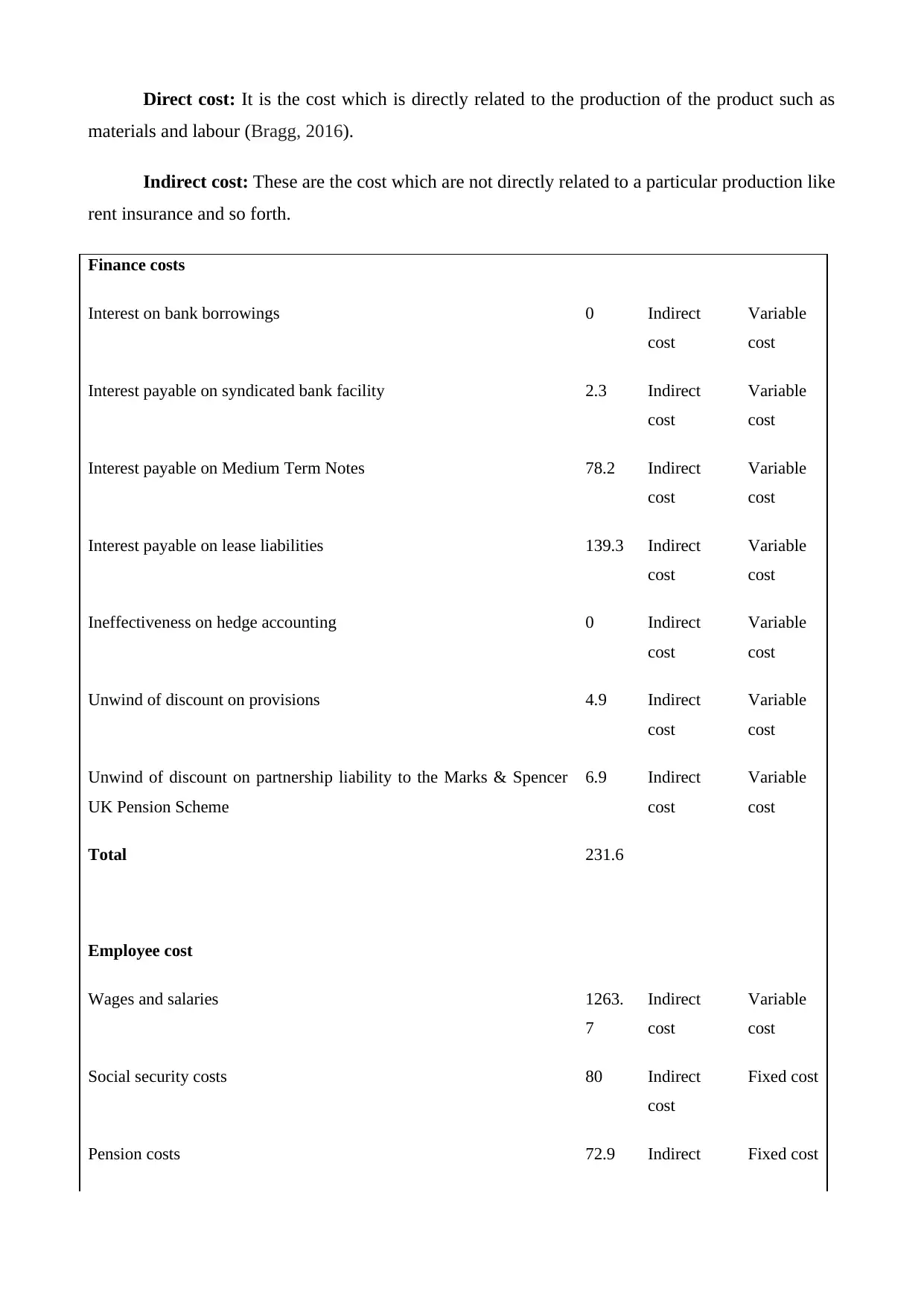
Direct cost: It is the cost which is directly related to the production of the product such as
materials and labour (Bragg, 2016).
Indirect cost: These are the cost which are not directly related to a particular production like
rent insurance and so forth.
Finance costs
Interest on bank borrowings 0 Indirect
cost
Variable
cost
Interest payable on syndicated bank facility 2.3 Indirect
cost
Variable
cost
Interest payable on Medium Term Notes 78.2 Indirect
cost
Variable
cost
Interest payable on lease liabilities 139.3 Indirect
cost
Variable
cost
Ineffectiveness on hedge accounting 0 Indirect
cost
Variable
cost
Unwind of discount on provisions 4.9 Indirect
cost
Variable
cost
Unwind of discount on partnership liability to the Marks & Spencer
UK Pension Scheme
6.9 Indirect
cost
Variable
cost
Total 231.6
Employee cost
Wages and salaries 1263.
7
Indirect
cost
Variable
cost
Social security costs 80 Indirect
cost
Fixed cost
Pension costs 72.9 Indirect Fixed cost
materials and labour (Bragg, 2016).
Indirect cost: These are the cost which are not directly related to a particular production like
rent insurance and so forth.
Finance costs
Interest on bank borrowings 0 Indirect
cost
Variable
cost
Interest payable on syndicated bank facility 2.3 Indirect
cost
Variable
cost
Interest payable on Medium Term Notes 78.2 Indirect
cost
Variable
cost
Interest payable on lease liabilities 139.3 Indirect
cost
Variable
cost
Ineffectiveness on hedge accounting 0 Indirect
cost
Variable
cost
Unwind of discount on provisions 4.9 Indirect
cost
Variable
cost
Unwind of discount on partnership liability to the Marks & Spencer
UK Pension Scheme
6.9 Indirect
cost
Variable
cost
Total 231.6
Employee cost
Wages and salaries 1263.
7
Indirect
cost
Variable
cost
Social security costs 80 Indirect
cost
Fixed cost
Pension costs 72.9 Indirect Fixed cost
⊘ This is a preview!⊘
Do you want full access?
Subscribe today to unlock all pages.

Trusted by 1+ million students worldwide
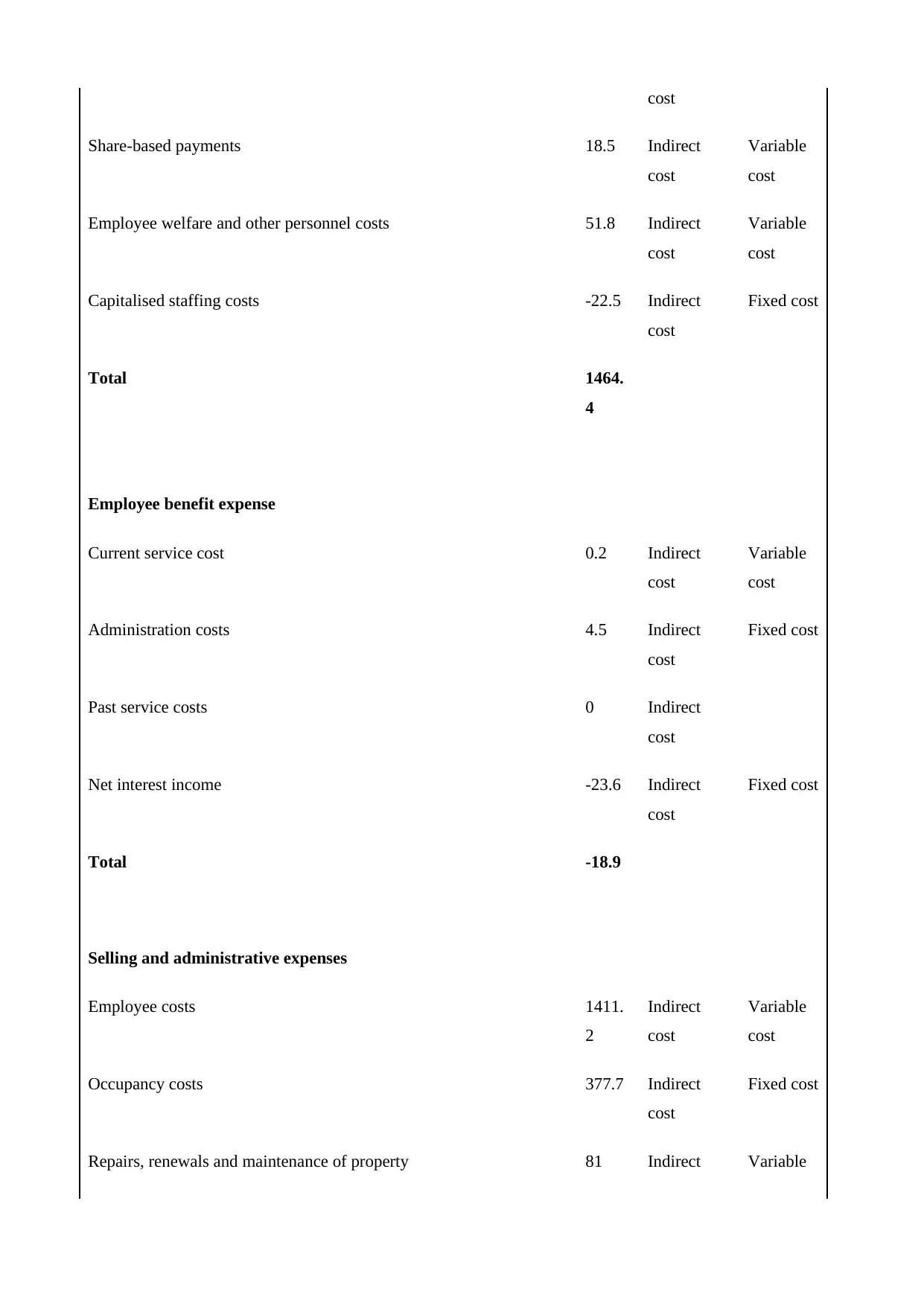
cost
Share-based payments 18.5 Indirect
cost
Variable
cost
Employee welfare and other personnel costs 51.8 Indirect
cost
Variable
cost
Capitalised staffing costs -22.5 Indirect
cost
Fixed cost
Total 1464.
4
Employee benefit expense
Current service cost 0.2 Indirect
cost
Variable
cost
Administration costs 4.5 Indirect
cost
Fixed cost
Past service costs 0 Indirect
cost
Net interest income -23.6 Indirect
cost
Fixed cost
Total -18.9
Selling and administrative expenses
Employee costs 1411.
2
Indirect
cost
Variable
cost
Occupancy costs 377.7 Indirect
cost
Fixed cost
Repairs, renewals and maintenance of property 81 Indirect Variable
Share-based payments 18.5 Indirect
cost
Variable
cost
Employee welfare and other personnel costs 51.8 Indirect
cost
Variable
cost
Capitalised staffing costs -22.5 Indirect
cost
Fixed cost
Total 1464.
4
Employee benefit expense
Current service cost 0.2 Indirect
cost
Variable
cost
Administration costs 4.5 Indirect
cost
Fixed cost
Past service costs 0 Indirect
cost
Net interest income -23.6 Indirect
cost
Fixed cost
Total -18.9
Selling and administrative expenses
Employee costs 1411.
2
Indirect
cost
Variable
cost
Occupancy costs 377.7 Indirect
cost
Fixed cost
Repairs, renewals and maintenance of property 81 Indirect Variable
Paraphrase This Document
Need a fresh take? Get an instant paraphrase of this document with our AI Paraphraser
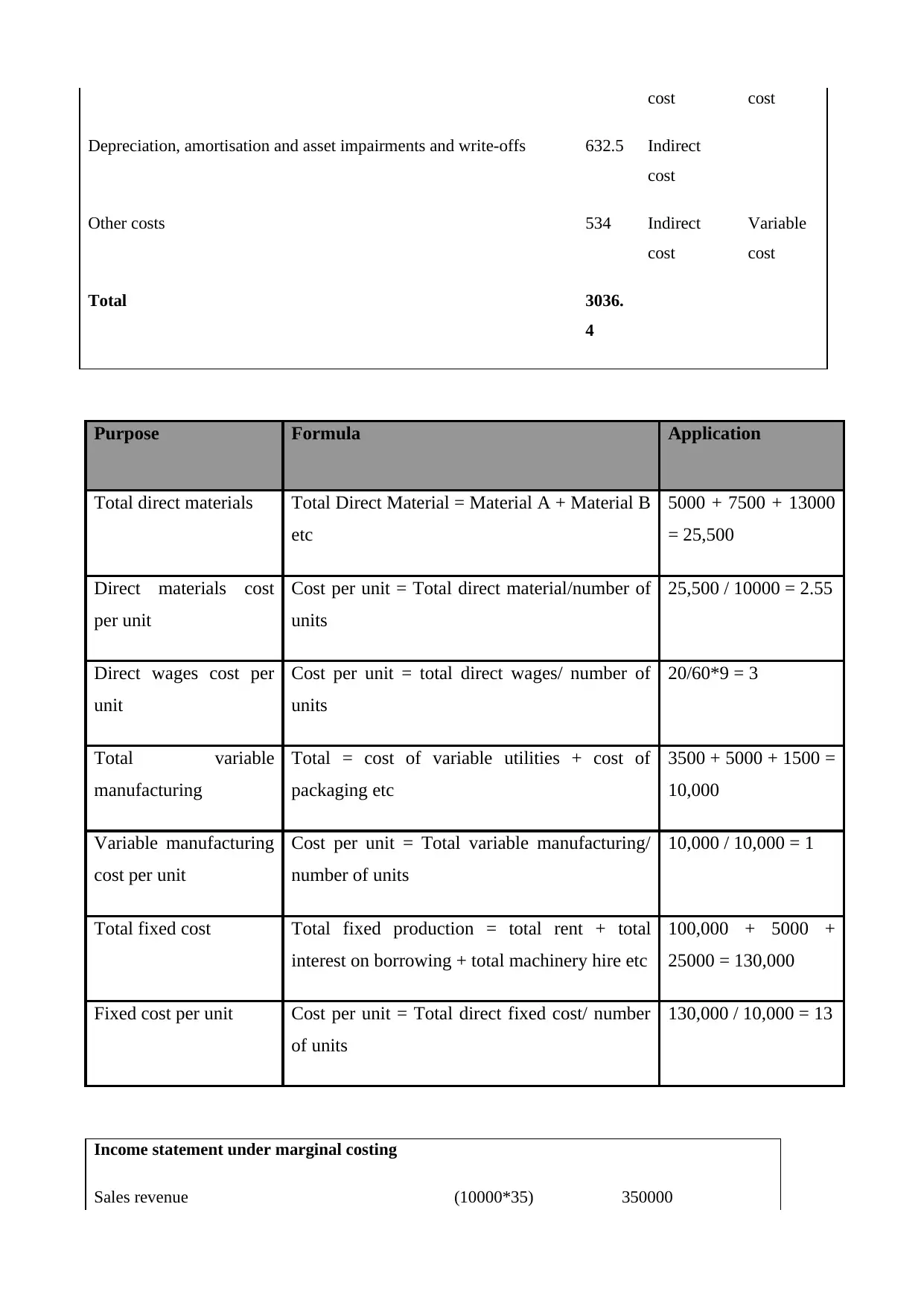
cost cost
Depreciation, amortisation and asset impairments and write-offs 632.5 Indirect
cost
Other costs 534 Indirect
cost
Variable
cost
Total 3036.
4
Purpose Formula Application
Total direct materials Total Direct Material = Material A + Material B
etc
5000 + 7500 + 13000
= 25,500
Direct materials cost
per unit
Cost per unit = Total direct material/number of
units
25,500 / 10000 = 2.55
Direct wages cost per
unit
Cost per unit = total direct wages/ number of
units
20/60*9 = 3
Total variable
manufacturing
Total = cost of variable utilities + cost of
packaging etc
3500 + 5000 + 1500 =
10,000
Variable manufacturing
cost per unit
Cost per unit = Total variable manufacturing/
number of units
10,000 / 10,000 = 1
Total fixed cost Total fixed production = total rent + total
interest on borrowing + total machinery hire etc
100,000 + 5000 +
25000 = 130,000
Fixed cost per unit Cost per unit = Total direct fixed cost/ number
of units
130,000 / 10,000 = 13
Income statement under marginal costing
Sales revenue (10000*35) 350000
Depreciation, amortisation and asset impairments and write-offs 632.5 Indirect
cost
Other costs 534 Indirect
cost
Variable
cost
Total 3036.
4
Purpose Formula Application
Total direct materials Total Direct Material = Material A + Material B
etc
5000 + 7500 + 13000
= 25,500
Direct materials cost
per unit
Cost per unit = Total direct material/number of
units
25,500 / 10000 = 2.55
Direct wages cost per
unit
Cost per unit = total direct wages/ number of
units
20/60*9 = 3
Total variable
manufacturing
Total = cost of variable utilities + cost of
packaging etc
3500 + 5000 + 1500 =
10,000
Variable manufacturing
cost per unit
Cost per unit = Total variable manufacturing/
number of units
10,000 / 10,000 = 1
Total fixed cost Total fixed production = total rent + total
interest on borrowing + total machinery hire etc
100,000 + 5000 +
25000 = 130,000
Fixed cost per unit Cost per unit = Total direct fixed cost/ number
of units
130,000 / 10,000 = 13
Income statement under marginal costing
Sales revenue (10000*35) 350000
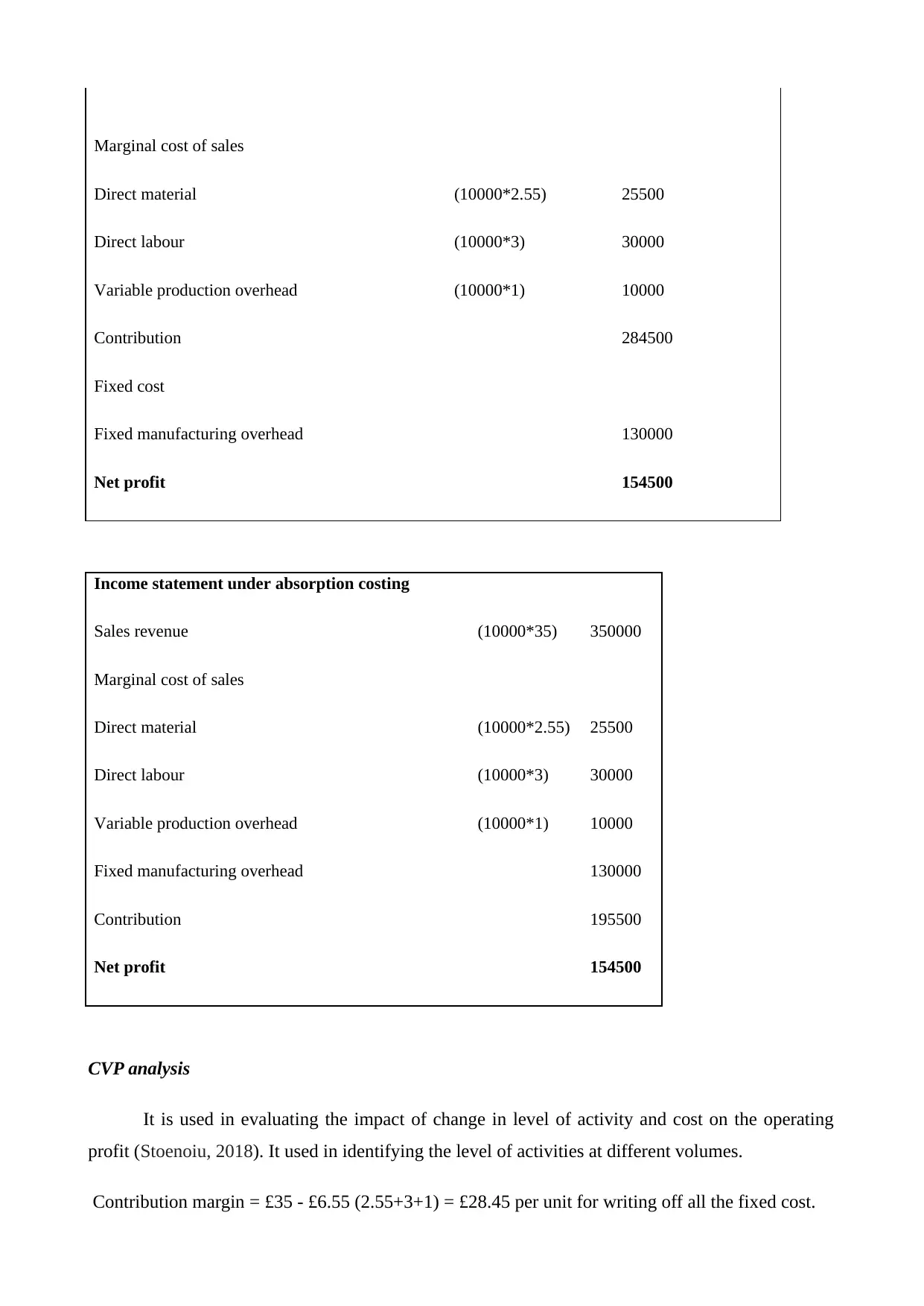
Marginal cost of sales
Direct material (10000*2.55) 25500
Direct labour (10000*3) 30000
Variable production overhead (10000*1) 10000
Contribution 284500
Fixed cost
Fixed manufacturing overhead 130000
Net profit 154500
Income statement under absorption costing
Sales revenue (10000*35) 350000
Marginal cost of sales
Direct material (10000*2.55) 25500
Direct labour (10000*3) 30000
Variable production overhead (10000*1) 10000
Fixed manufacturing overhead 130000
Contribution 195500
Net profit 154500
CVP analysis
It is used in evaluating the impact of change in level of activity and cost on the operating
profit (Stoenoiu, 2018). It used in identifying the level of activities at different volumes.
Contribution margin = £35 - £6.55 (2.55+3+1) = £28.45 per unit for writing off all the fixed cost.
Direct material (10000*2.55) 25500
Direct labour (10000*3) 30000
Variable production overhead (10000*1) 10000
Contribution 284500
Fixed cost
Fixed manufacturing overhead 130000
Net profit 154500
Income statement under absorption costing
Sales revenue (10000*35) 350000
Marginal cost of sales
Direct material (10000*2.55) 25500
Direct labour (10000*3) 30000
Variable production overhead (10000*1) 10000
Fixed manufacturing overhead 130000
Contribution 195500
Net profit 154500
CVP analysis
It is used in evaluating the impact of change in level of activity and cost on the operating
profit (Stoenoiu, 2018). It used in identifying the level of activities at different volumes.
Contribution margin = £35 - £6.55 (2.55+3+1) = £28.45 per unit for writing off all the fixed cost.
⊘ This is a preview!⊘
Do you want full access?
Subscribe today to unlock all pages.

Trusted by 1+ million students worldwide
1 out of 21
Related Documents
Your All-in-One AI-Powered Toolkit for Academic Success.
+13062052269
info@desklib.com
Available 24*7 on WhatsApp / Email
![[object Object]](/_next/static/media/star-bottom.7253800d.svg)
Unlock your academic potential
Copyright © 2020–2025 A2Z Services. All Rights Reserved. Developed and managed by ZUCOL.





